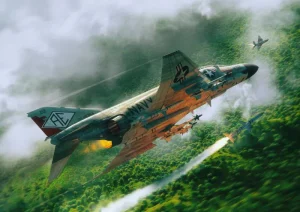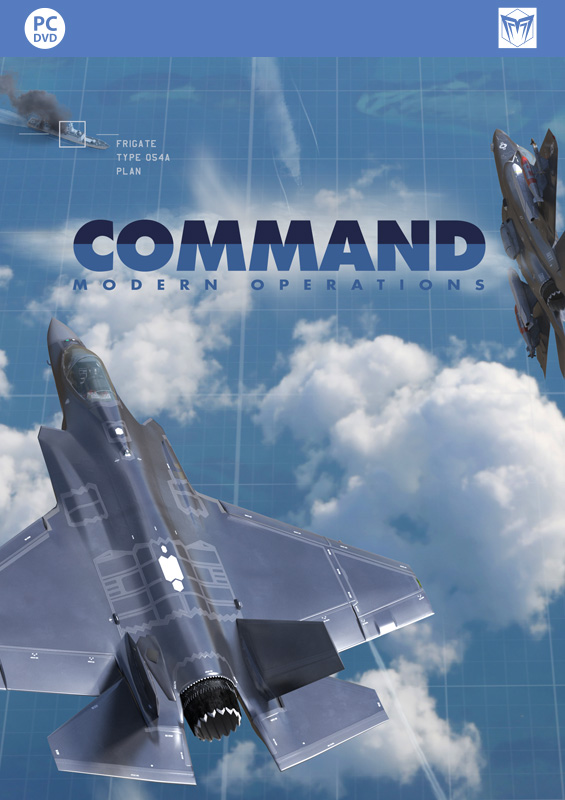Why dogfights are not a high priority in Command
 So, this question gets asked occasionally in public fora: Given how good Command is at modelling various aspects of air operations and air combat, why is its modelling of close air-combat (the “boom and zoom” maneuvering that is a staple of History Channel specials) comparatively deficient? Why is its improvement (e.g. the implementation of various common 3D maneuvers) not a high priority for the dev team?
So, this question gets asked occasionally in public fora: Given how good Command is at modelling various aspects of air operations and air combat, why is its modelling of close air-combat (the “boom and zoom” maneuvering that is a staple of History Channel specials) comparatively deficient? Why is its improvement (e.g. the implementation of various common 3D maneuvers) not a high priority for the dev team?
ANSWER: Because stick-and-rudder close-ACM is as relevant to (wartime) air ops in general as close-quarters knife-fighting is to ground operations in general: A niche condition that gets far more exposure in media & popular culture than its actual share of combat. (Yes, exceptions exist).
This obviously needs some unpacking. Contrary to the popular notion that most air engagements are decided by “see the white in their eyes”-range close-ACM, the historical record is abundantly clear that the vast majority of air kills have been scored by either surprise attacks, high-speed attacks without any significant maneuver or (more recently) standoff or BVR attacks which leave no chance for any maneuvers at all. The overwhelming majority of standoff kills in the modern era is generally understood by the public as a consequence of improved technology (frequently accompanied by the notion that “modern technology has removed any tension & skill from air combat, it’s all just pushing buttons on a radar screen” – another gross misperception).
The proliferation of weapons with high off-boresight (HOBS) capability since the mid-80s has further eroded the importance of aircraft agility.
As Abhirup Sengupta points out:
In [the] real world a visual-combat doesn’t occur in isolation, nor do you have both parties doing a fly-past before shooting at one another. Contrary to popular culture, [the] vast majority of WVR combat doesn’t involve air combat manoeuvring (ACM).[…]
[The] vast majority of ‘dogfights’ in the last 100 years of air combat had nothing to do with manoeuvrability but everything to do with Situational Awareness followed by Weapon systems over the last 50 years. […]
Secondly, there’s a massive shift in visual-combat with the introduction of off-boresight (HOBS) missiles that can be cued 90° to either side of the nose, essentially eliminating the need to get behind enemy’s 6′. Modern off-boresight missiles like AIM-9x can easily engage a target over the shoulder. Today a real world visual-confrontation isn’t dictated by who is more manoeuvrable but who has better off-boresight missile to take the First-shot.
The F-35 takes this to [a] whole new level with DAS giving it 360° Search-Track-Attack capability. Where Su-57 and J-20 can cue a missile 180° in the forward hemisphere (~240° in case of Su-57 against non-stealthy targets due to the side-arrays), the F-35 can cue a missile 360° spherically in any direction. And it doesn’t need to rely on AIM-9x for that, the AMRAAMs too have increased off-boresight envelope since the AIM-120C7 specifically to facilitate the increased targeting envelope of F-35.
At this point, the common argument of the boom-and-zoom enthusiasts is “well yeah, nowadays it’s all about lobbing AAMs at the other guy (and in the future lasers and microwaves), but in the ‘good old days’ men were men and they pulled hard Gs with various elaborate 3D manouvers to get on each other’s six”.
We are sorry to burst that bubble, but… no. Dogfights have been historically been the exception rather than the rule, even from the very early days of aviation, when weapon ranges were really “white of their eyes”. Air combat legends like Manfred von Richhoffen, Richard Bong, Douglas Bader, Adolf Galland, Robin Olds or Yevgeny Pepelyaev got the vast majority of their kills the old-fashioned but efficient way: Attack from a severe advantage of either surprise or vastly superior strength (positional-, kinematic- or weaponry-wise), and give the target little or no chance to react at all. Glorious dogfights like Cunningham-vs-Tomb or Richthofen-vs-Hawker, or massive furballs like the Mansoura air battle, are celebrated precisely because they are vanishingly rare (and visually spectacular for observers), and their protagonists would rather do their job quickly and efficiently rather than go through the protracted, often exhaustive ordeal that they did.
Mike Spick highlights this in his seminal “Modern Air Combat (1983)”, and places ACM agility well below other attributes in the list of desirable quantities for a fighter:
A detailed examination of aerial victories from 1914 to the present day reveals one startling fact. Something like four out of every five aircraft shot down by fighters never saw their assailant until too late, if at all!
During World War I a pilot frequently knew he was in a fight but failed to see his assailant pull in behind him. Many of the early aces, and McCudden in particular, told of carefully stalking an unsuspecting victim. In the skies over Vietnam, a pilot’s first intimation that he was under attack was often when his tailpipe blew up!
An exception was the massed daylight bomber raids of World War II, when bomber pilots almost always knew that they were under attack but were not free to manoeuvre against it.
The most important attribute of a modern fighter is its ability to achieve surprise. Its second most important attribute is to avoid being surprised. The third most important requirement is to have sufficient strength numerically to match the enemy in the air. Numerical parity on the ground is not enough. Many instances have occurred in the past where qualitatively superior fighters have been vanquished by superior numbers.[…]
The fourth requirement is the ability to outmanoeuvre an opponent to gain a firing position. The historical justification for this is that, whereas only one-fifth of aerial victories are gained at this stage (which accounts for it being so low in the order of priorities), one-fifth of all aerial victories still adds up to a considerable total. The ability to outmanoeuvre an opponent is probably the most discussed area of air combat, and includes all the exciting factors such as speed, rate of climb and so on. The fact that it comes only fourth in the order of priorities does not mean that it is unimportant, just that it is not as important as is popularly supposed. To put matters into their correct perspective, the capability of the aeroplane in the manoeuvre phase is nowhere near as important as the capability of the pilot to make the best use of the aeroplane he has been given.
The final requirement is the ability to obtain kills from fleeting chances. Historically this ability has always existed, even if few pilots were marksmen enough to exploit it fully. When fighters began to be armed with missiles only, much of this capability was lost. […] The weaponry of a fighter should be usable at all ranges and all opportunities.
It is tempting here to note how far-prescient Spick was his “shopping list” of then-current and future (ie. today’s) fighter requirements: in 1983 the F-117 was still black-classified, Eurofighter Typhoon was in its embryonic ACA/EAP “tech demo” pre-prototypes and the ATF (pre-F-22) design requirements still heavily emphasized speed, range and maneuverability (the sharp turn to emphasis on VLO was announced to the design candidates only in the mid-80s).
It is also telling to compare Spick’s list with the technical, tactical and operational attributes already modelled well in Command:
- “Achieve surprise”: Sensor models and counter-detection techniques, including VLO (both on radar and IR) and deception-focused electronic warfare. Command already excels on this part, with the exception of deception-based EW such as false targets, which is a planned future addition.
Spick also references sustained (no afterburner) speed as a factor in minimizing detection (supercruise comes to mind), as well as the importance of differences in out-of-cockpit visibility, both familiar items to every user of Command. - “Avoid being surprised”: Sensor models and superior SA through communications and sensor/data fusion. Command already does the former well, already features comms disruption and isolation, and explicit modelling of differential sensor/data fusion is a planned future addition.
- “Have sufficient strength numerically to match the enemy in the air”: This encompasses a wide range of different “operational” factors such as maintenance availability, sortie rates, weapons load per sortie, virtual attrition (e.g. aborting a mission or jettison of weapons in order to survive), high-low numbers mix, procurement quantities based on projected unit cost (there was a reason the F-16 was designed from the get-go as an affordable aircraft) and other items. Command models all such factors well (and they are nowhere to be found in the typical History Channel documentaries on “dogfights”).
- “Outmaneuver an opponent”: This is the actual close-ACM phase, where Command is arguably most deficient on the overall air combat timeline.
- “Obtain kills from fleeting chances”: Here Spick refers to overall weapons reliability and guidance flexibility; a weapon that requires repeated shots for a kill or ties down its platform to a predictable and thus vulnerable course loses a lot of its utility (Spick loved the promise of AMRAAM and would probably be ecstatic over CEC). Command of course places heavy emphasis on modeling both items.
In summary: Command’s dev team is aware of the various issues currently handicapping its close-ACM modeling. There are various ideas and plans for rectifying each of them, but they all take lower priority than other features in the development stack. Why? Because close-ACM is not nearly as important as most people think, and never was.
Some background reading on this: https://csbaonline.org/research/publications/trends-in-air-to-air-combat-implications-for-future-air-superiority
Comments
Leave a Reply
You must be logged in to post a comment.





